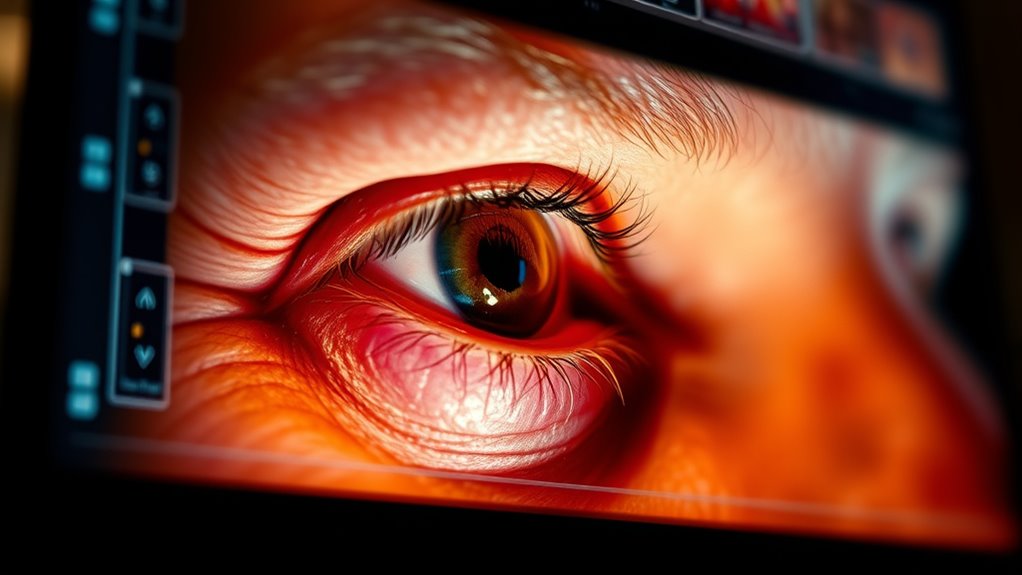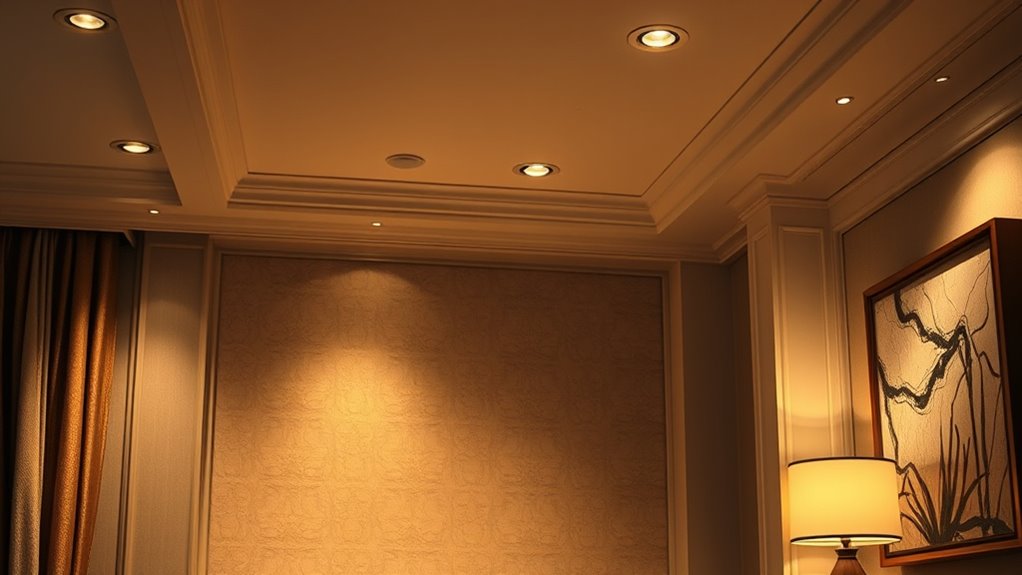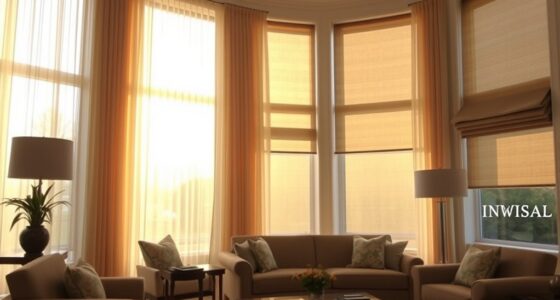To create layered lighting for mature eyes, combine ambient, task, and accent lighting to improve visibility and reduce eye strain. Use dimmable warm-colored ambient lights to mimic natural daylight, add adjustable task lights for specific activities, and include accent fixtures to highlight features without causing glare. Properly balancing these layers helps make your space cozy yet functional. Keep exploring to discover effective ways to optimize your lighting for comfort and clarity.
Key Takeaways
- Prioritize warm, dimmable ambient lighting to reduce glare and create a comfortable overall environment.
- Incorporate adjustable task lighting with high CRI LEDs for clear visibility during detailed activities.
- Use accent lighting to highlight features softly, avoiding direct glare into the eyes.
- Maximize natural light with diffused window treatments to support circadian rhythms and reduce eye strain.
- Ensure seamless integration of all layers for adaptable, glare-free illumination tailored to mature eyes.

Layered lighting plans are essential for creating a functional and inviting space, as they combine different types of lighting to serve various purposes. When designing a lighting scheme for mature eyes, it’s important to focus on clarity, brightness, and reducing eye strain. As you age, your eyes require more light to see clearly, but you also need to avoid harsh glare that can cause discomfort. By layering your lighting, you can achieve a balanced environment that enhances visibility while maintaining ambiance.
Start with ambient lighting, which provides overall illumination for the room. Opt for fixtures that emit a soft, even glow, such as ceiling-mounted LED panels or recessed lights with dimmable features. These allow you to adjust brightness levels based on your needs, ensuring the space isn’t too dim or overly bright. Avoid overly bright or flickering lights, which can cause eye fatigue over time. Instead, aim for a warm white color temperature around 3000K to 3500K, mimicking natural light and reducing strain.
Start with dimmable, warm white ambient lighting to reduce eye strain and create a cozy, well-balanced space.
Next, add task lighting to specific areas where you perform detailed activities like reading, writing, or crafts. Use adjustable lamps or directional fixtures that let you direct light exactly where you need it. For mature eyes, it’s helpful to have a higher light output—around 75 to 100 lumens per square foot—so you can see clearly without squinting. Position task lights to minimize shadows and glare, avoiding placing them directly behind your head or in your line of sight. Consider using LED bulbs with a high Color Rendering Index (CRI) to ensure colors appear vibrant and true, aiding in activities that require color accuracy.
Accent lighting plays a crucial role in creating depth and highlighting key features in your space. Use wall sconces, picture lights, or small spotlights to draw attention to artwork, architectural details, or plants. These lights should be softer and directional, providing visual interest without overwhelming the space or adding unnecessary glare. Be mindful of positioning to prevent direct glare into your eyes, especially when sitting or working nearby.
Finally, incorporate natural light as much as possible. Use window treatments that diffuse sunlight without blocking it completely, such as sheer curtains or blinds. Natural light can help regulate your circadian rhythm and improve overall visual comfort. Proper lighting design involves harmonizing all layers so that each enhances the other without causing strain or discomfort. Throughout your space, ensure that all lighting layers work harmoniously, allowing you to switch between different levels of brightness seamlessly. This layered approach not only helps you see better but also creates a warm, welcoming atmosphere that’s easy on your eyes.
Frequently Asked Questions
How Does Layered Lighting Reduce Eye Strain for Older Adults?
Layered lighting reduces eye strain for older adults by providing balanced illumination that minimizes glare and shadows. When you use a combination of ambient, task, and accent lighting, your eyes don’t have to work as hard to see clearly. This setup improves contrast and reduces the effort needed to focus, making everyday activities easier and more comfortable. Properly layered lighting creates a visually soothing environment that supports your eye health and comfort.
What Colors of Light Are Best for Mature Eyes?
Imagine a gentle sunrise painting your room in soft, warm hues. For mature eyes, warm white or soft yellow light is best, mimicking natural daylight without harsh glare. These colors reduce eye strain and enhance contrast, making reading and tasks easier. You should avoid cool blue or overly bright lights, which can cause discomfort. Opt for adjustable lighting to match your needs and create a cozy, eye-friendly environment.
Can Layered Lighting Help With Age-Related Vision Conditions?
Yes, layered lighting can help with age-related vision conditions. By combining ambient, task, and accent lights, you can reduce eye strain and improve visibility. You’ll find it easier to focus on details and navigate spaces safely. Adjusting lighting levels and using brighter, well-diffused lights can lessen glare and shadows, making daily activities more comfortable and less tiring for your eyes.
How Do I Adjust Lighting for Different Times of Day?
You should adjust your lighting as the day progresses to stay sharp. Start with bright, cool light in the morning to energize your eyes, then switch to softer, warmer tones in the evening to reduce strain and prepare for rest. Use dimmers or smart lighting systems to make quick changes. This simple shift keeps your vision comfortable and guarantees you’re never left in the dark when it matters most.
Are There Specific Fixtures Designed for Mature Eye Comfort?
Yes, you should look for fixtures with adjustable brightness, warm color temperatures, and diffused light to comfort mature eyes. Opt for LED fixtures with dimming capabilities, as they let you tailor the light to your needs. Fixtures with softer, broader beams reduce glare and eye strain. When choosing, prioritize designs that offer flexibility and minimize harsh shadows, helping you see clearly and comfortably throughout the day.
Conclusion
So, next time you marvel at a perfectly lit room, remember it’s all about layers—something your mature eyes might secretly crave. Ironically, as your vision ages, you’ll rely more on strategic lighting than ever before. With the right plan, you’ll see everything clearly—literally. Who knew that the secret to sharp sight isn’t just about brighter bulbs, but smarter lighting? It’s a small detail that makes a big difference—until you realize it’s been hiding in plain sight all along.









